Western Approaches Tactical Unit
The Western Approaches Tactical Unit (WATU) was a unit of the British Royal Navy created in January 1942 to develop and disseminate new tactics to counter German submarine attacks on trans-Atlantic shipping convoys.[1] It was led by Captain Gilbert Roberts and was principally staffed by officers and ratings from the Women's Royal Naval Service (Wrens).[2] Their primary tool for studying U-boat attacks and developing countermeasures was wargames. After the U-boat threat to merchant shipping was defeated, WATU continued to develop anti-submarine tactics for later stages of the war, including Operation Overlord and the Pacific War. WATU trained naval officers in its tactics by hosting week-long training courses in which the students played wargames. WATU formally ceased operations at the end of July 1945.
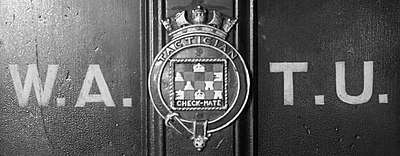
Mission
During World War 1, German submarines (U-boats) sank merchant ships in the Atlantic Ocean so as to deny supplies to its enemies in Europe. Britain reacted by organizing the merchant ships into convoys which were escorted by warships armed with depth charges. This strategy proved effective at repelling U-boats. During the inter-war years, Germany secretly developed new submarine tactics to counter the convoy system. The products of this research were the "wolfpack" tactics, wherein submarines would attack convoys in groups, exploiting the weaknesses of the convoy system, and new advances in submarine technology. The British, by contrast, had neglected to study submarine tactics during the inter-war years. They entered World War 2 assuming that the U-boats would operate much as they had during the previous war, unaware that the Germans would come at them with new tricks.[3]
As soon as Britain declared war on Germany (3 Sept 1939), Germany sent its U-boats to attack transatlantic shipping. The U-boats had a devastating effect. In 1938, Britain had received 68 million tons of imports, but in 1941 the U-boats reduced this to 26 million.[4] Britain was not a self-sufficient nation, and eventually its reserves of food would run out and it would be forced to capitulate to prevent a famine.[5] In March 1941, Prime Minister Winston Churchill declared that Britain was fighting "the Battle of the Atlantic", and made anti-submarine warfare a top priority.
The Royal Navy understood, from intercepted radio transmissions, that the U-boats were operating in coordinated groups, but did not know the specifics of their tactics.[6] On 1 January 1942, Admiral Cecil Usborne assigned Commander Gilbert Roberts to establish a wargaming unit at the Western Approaches Command in Liverpool, to analyze the submarine attacks and develop defensive tactics.[7] Roberts had played naval wargames during a two-year stint at the Portsmouth Tactical School, using them to develop new strategies and tactics. Additionally, Roberts was a gifted communicator who would be able to train commanders in the tactics he was to develop.[8]
Roberts moved to Liverpool to set up his tactical unit on the top floor of the Western Approaches headquarters. Most of the staff at Western Approaches were women from the Women's Royal Naval Service (colloquially referred to as "Wrens"), and likewise Roberts recruited most of his staff from the Wrens. At total of sixty-six Wrens served at WATU from 1942 to 1945.[9]
Roberts and his team reviewed battle reports from convoy escort commanders, recreated the battles in wargames in order to deduce how the U-boats were operating, and then devised tactics by which the escorts could defeat the U-boats. Their first product was a tactic codenamed Raspberry, developed that January (see below). As well as devising tactics, WATU also trained naval officers in their use by having them participate in wargames. The first batch of trainees arrived on 2 February 1942. The training course lasted six days, from Monday to Saturday, and was held every week from February 1942 to the last week of July 1945. Up to fifty officers at once took the course.[10] WATU not only trained British officers, but also officers from other countries such as Canada, New Zealand, Norway, South Africa, Poland, and Free France. On Sundays, Roberts occasionally demonstrated his wargames to visiting Americans,[11] but no American officers actually took his course. The American admiral Ernest King did not permit any American officers to take the course as he disliked the British Royal Navy.[12]
In May 1943, Admiral Karl Doenitz ordered the U-boats to withdraw from the Atlantic, allowing merchant convoys to pass unmolested. In 1944, food imports to Britain rose to 56.9 million tons.[13]
WATU continued to develop anti-submarine tactics and train officers until the end of the war. It officially ceased operations at the end of July 1945. It had trained close to 5,000 officers over its lifetime.[14]
Legacy
What makes WATU a noteworthy episode in the history of military wargaming is that it used wargames to investigate real scenarios that were occurring during an ongoing war and develop solutions that were immediately implemented in the field. By contrast, most wargames are played during peacetime to prepare officers for potential wars, and the scenarios they explore are either hypothetical or happened many years ago, and may not be relevant to the next conflict when it comes due to unforeseen factors such as new technology or rules of engagement.
Headquarters
Western Approaches Command was an operational command of Britain's Royal Navy, tasked with safeguarding British shipping in the Western Approaches (the seas to the west of Ireland and Britain). Initially headquartered in Plymouth, on the southern coast of Britain, it was moved north to Liverpool in February 1941. After France had fallen to the Germans, North Atlantic shipping convoys had been diverted around the north of Ireland to evade the German navy. Relocating Western Approaches Command to Liverpool sped up communications. Its headquarters was Derby House, a building located behind Liverpool's town hall; today the headquarters is a museum.[lower-alpha 1] The top floor, comprising eight rooms, was allocated to WATU.[15] Most of the staff at Western Approaches HQ were women from the Women's Royal Naval Service. Colloquially, they were referred to as "Wrens". When Roberts arrived at Western Approaches in January 1942, its commander-in-chief was Admiral Percy Noble, who was replaced by Admiral Max Horton in November 1942.
Staff and students
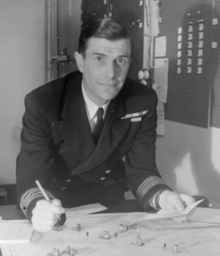
A total of sixty-six women from the Women's Royal Naval Service (Wrens) served at WATU from 1942 to 1945.[9]
Staff
- Captain Gilbert Roberts - Director of WATU. Once commanded a destroyer but contracted tuberculosis in late 1937 and was barred from serving at sea.[16]
- Laura Janet Howes - Wren officer. Born in Antigua. Mathematical prodigy.
- Elizabeth Drake - Wren officer. When WATU was established, she was already working at Derby House as a plotter.
- Nancy Wales - Wren officer. Born in Kingston upon Hull, joined the Wrens in 1941. She was a passionate hockey player, and was selected for her understanding of team tactics.
- Jean Laidlaw - Wren officer. Former Sea Ranger and chartered accountant.
- Janet Okell - Wren rating. She was only 19 years old when she joined WATU in January 1942. She served at WATU for the whole duration. Okell was initially trained as a plotter, but she was soon participating in wargames as a player, commanding U-boats and escort ships alike.
Trainees
Overview of the wargames
Gilbert Roberts was first introduced to wargaming during a stint at the Portsmouth Tactical School from 1935 to 1937. Roberts took to wargaming with great enthusiasm, and developed his own rulesets. Roberts' wargames were based on the wargames developed by Fred T. Jane in 1898 (Jane Naval Wargame and Fighting Ships).[17] Despite the strong effect that U-boats had during World War 1, Roberts' wargames at Portsmouth did not simulate submarine warfare, nor attacks on merchant convoys. In fact, nobody in the Royal Navy studied submarine warfare through wargames until the establishment of WATU in 1942.[3]
At WATU, the wargames were conducted in the largest room of the top floor of Western Approaches HQ. The floor was covered with brown linoleum and in the center was a painted grid. This grid was the game board. The gridlines were spaced ten inches apart, representing one nautical mile. Around the grid were vertical screens of canvas that had peepholes cut into them. The players who controlled the escort ships had to stand behind the screens and could only view the game board through the peepholes. The players who controlled the U-boats did not stand behind the screens and had an unrestricted view of the game board. The ships and surfaced U-boats were represented on the game board by tiny wooden models.[18] The U-boats' movement lines were drawn in green chalk, a color which contrasted poorly with the brown tint of the floor; and when viewed from an angle, these lines were practically invisible, so the players behind the screens couldn't make them out. The escort ships' movement lines were drawn with white chalk, which could be clearly perceived by the players behind the screens.[19][20]
The players were given two minutes per turn to make decisions and give orders.[21] The players issued their orders for their imaginary ships on pieces of paper that they passed to the Wrens—this prevented their opponents on the other side of the room from overhearing. The Wrens would then get down on the floor and compute the outcomes of the players' orders. Roberts provided the Wrens with the performance characteristics of all ships concerned: the range of the U-boat's torpedoes (5,400 yards[22]), the speed of the ships, their turn speed, the precise capabilities of the escorts' sonar (then known as ASDIC), how engine noise might distort listening attempts, visibility at night, etc. The Wrens would plot the trajectories of the ships on the game board with chalk.
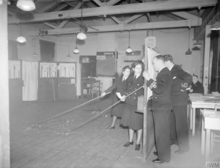 A wargame in progress. The men on the far-right command the escort ships and may only view the game board through holes in the screen.
A wargame in progress. The men on the far-right command the escort ships and may only view the game board through holes in the screen.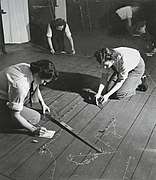 Wrens computing the outcomes of player moves.
Wrens computing the outcomes of player moves.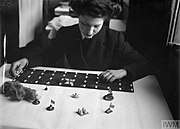 A Wren organizing game materials. The wooden pieces represent escort ships, the black board with white shapes represents a convoy, the wire wool represents smoke.
A Wren organizing game materials. The wooden pieces represent escort ships, the black board with white shapes represents a convoy, the wire wool represents smoke.
Tactics developed
Notes on WW2 submarine warfare
Submarines of this era were powered by diesel engines and batteries. They could only use their diesel engines when surfaced, as these needed to breathe air to work. When submerged, the submarine used lead-acid batteries. The batteries were less powerful than the engine, so the submarine was reduced to about half-speed: e.g. a Type VIIC U-boat could travel at 17.7 knots (~32.8 km/h) on the surface but only 7.6 knots (~14 km/h) underwater. The batteries would be exhausted after an hour or so of underwater travel, depending on how heavily they were taxed. At that point, the U-boat would be forced to surface for air and recharge the batteries with the diesel engine.
The British were the first to equip their warships with sonar to hunt enemy submarines. They called this technology "ASDIC"; the term "sonar" was later coined by the Americans. This technology sent loud pings into the water and located submarines by the echoes. The U-boats could hear these pings, of course, so they would know they were being hunted. In practice, ASDIC had an average detection range of 1,300 yards (~1,200 meters).[23] ASDIC could be ineffective if there was too much ambient noise in the water. The maximum speed at which a ship could travel while using its ASDIC was about 15 knots (~28 km/h), beyond which the noise of its own propeller and engine would drown out the echoes.[24] Both the U-boats and the warships also had hydrophones with which they could passively listen for sound in the water.
U-boats usually attacked at night. The cover of darkness allowed them to travel at surface depth with less risk of being spotted by look-outs. Escort ships were equipped with star shells, which when fired in the air would release a burning flare held aloft by a small parachute. This would illuminate the surface of the water, making it easy to spot a surfaced U-boat.
Warships used depth charges to sink submarines. These are bombs that are dropped into the water around the U-boat. The hydraulic shockwave produced by the explosion would seriously damage if not sink any submarine within 10 meters.
Raspberry
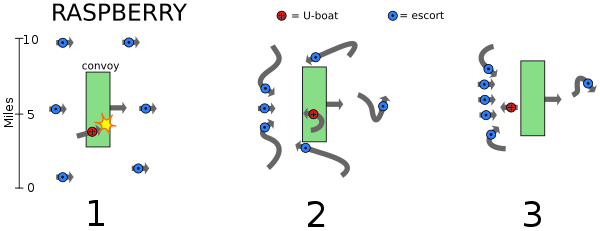
During World War 1, the U-boats typically attacked convoys from outside the formation, striking ships at the perimeter. But reports from convoys in 1942 showed that U-boats were sinking ships at the center of the formation. Roberts surmised that the U-boats were somehow sneaking into the formation undetected before firing their torpedoes.[25] Roberts and his team tested various ways by which a U-boat might sneak into a convoy, sink a ship, and escape undetected. Only one tactic worked on the game board: The U-boat snuck into the convoy from astern at surface depth so that it could use its diesel engine to match the speed of the convoy. Since these attacks happened at night, the U-boat was not easily spotted by look-outs, and once inside the convoy it was indistinguishable on radar and sonar. The U-boat would then sink a merchant ship with a torpedo at close range, then submerge and turn around to make its escape from astern.[26]
Roberts and his team then developed a counter-tactic to defeat this (see diagram). When a merchant ship in the convoy was torpedoed (1), the escort ships to the rear and flanks were to fall back and form a tight line behind the convoy (2). The line of escort ships was to then trawl for the U-boat using sonar, and drop depth charges when the U-boat was found (3). The escorts in front of the convoy were to stay ahead and move in a zig-zag patten in case the U-boat tried to escape from the front at full speed. At the suggestion of Jean Laidlaw (one of the Wrens), this tactic was codenamed Raspberry, as in "blowing a raspberry at Hitler".[1][27]
Raspberry was in part disseminated by having naval officers come and participate in the wargames at WATU where they could experiment with Raspberry themselves. Raspberry was also published in the Western Approaches Convoy Instructions, a manual for escort ship captains. Soon enough, reports of successful U-boat sinkings, made possible by Raspberry, came in.
Pineapple
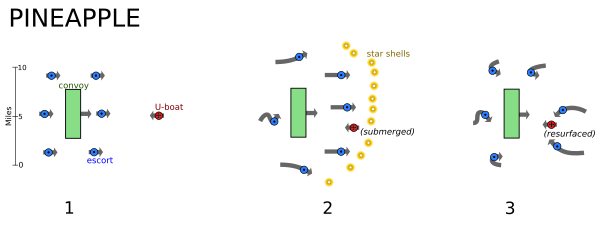
Pineapple was meant to be used when a possible U-boat was detected somewhere far ahead of the convoy—perhaps by reconnaissance planes, radio direction finders, or intelligence reports—but which hadn't yet been sighted by the escorts' look-outs. Ever since Raspberry was deployed, Roberts had been concerned that eventually the German navy would figure out how Raspberry was sinking their U-boats and alter their tactics. Perhaps a U-boat ahead of the convoy might observe Raspberry in action and report what it had seen to German naval command—this scenario was the impetus for developing Pineapple. The basic outline of this tactic was proposed by a visiting officer from the Canadian Navy. The diagram he drew for Roberts somewhat resembled a pineapple, so that's what Roberts called it.[28]
The basic idea of this tactic was to trick the U-boat (if it was there) into an encirclement where it could be sunk, or at least scare it off. Either was better than letting it lurk near the convoy where it might observe Raspberry in action or launch an attack of its own. When a possible U-boat was detected ahead of the convoy (1), the escort ships at the front and the flanks of the convoy were to advance at full speed for 15 minutes, firing star shells along the way to light up the surface of the water. This would prompt the U-boat to submerge if it wasn't already (2). While the escort ships moved at full speed, their sonar was useless because of the noise, so the U-boat was safe from detection at this point. The U-boat might now choose to slip away and attack another night, or it might press on towards the convoy, resurfacing after the escort ships passed by. After completing their 15-minute sortie, the escort ships were to turn around and slowly return to their normal positions around the convoy, all the while scanning the water with sonar. If the U-boat was still around, it would be detected in this sweep and attacked (3).[29]
Beta Search
Beta Search was a tactic to be employed when an escort's lookout had sighted a U-boat. When a U-boat was spotted, the escort ship that spotted it was to move in its direction without firing flares, using sonar, or dropping depth charges. The U-boat's captain would reflexively order his ship to submerge. The escort ship was then to pass over it, making the U-boat crew believe they had escaped detection. The wargames predicted that the U-boat would then make a slow turn and assume a vector parallel to the convoy. At this point, the escort ships were to rush to the U-boat's predicted position. The rumble of the convoy's propellers would mask their approach. Once over the U-boat's predicted position, the escort ships were to release their depth charges.
Beta Search was jointly developed by Roberts and Laidlaw. It was so named because U-boat transmissions always began with a "B-bar" in Morse code (dash-dot-dot-dot-dash).[30] Admiral Horton personally tested Beta Search in a wargame at WATU. He played the role of the U-boat, while Janet Okell played the role of the escorts. Five times in a row, Okell sank Horton's U-boat.
Step-Aside
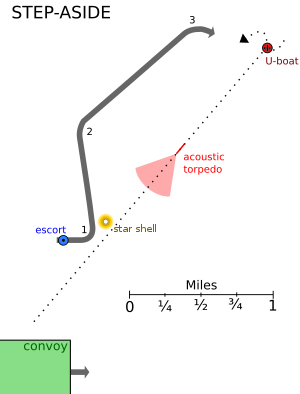
Step-Aside was a tactic by which an escort ship could defend itself from a U-boat armed with acoustic torpedoes, specifically the T5 Zaunkönig torpedo, which the German navy began using in August 1943. This torpedo used built-in hydrophones to guide itself to its target by sound.
In late 1943, Roberts received reports that the U-boats were regularly targeting the escort ships themselves. Stripped of their escorts, the merchant ships became easy prey. There was a common pattern in these reports: The escort ship would sight a U-boat and head straight for it, but then the escort ship would somehow get hit in the stern. This was a puzzling pattern. In those days it was very difficult for a submarine to torpedo a ship that was heading straight for it. From that angle, the ship had a narrow profile and with a slight turn it could easily dodge a conventional torpedo. U-boats preferred to attack ships from the side at an angle on the bow of 45 to 90 degrees. Furthermore, a conventional torpedo should have hit the escort ship in the bow because it was headed straight at the U-boat. A mine was suggested to be the mystery weapon but that was unlikely given how often this pattern repeated. Roberts surmised that the Germans were using a new type of torpedo that could guide itself to its target by following the sound of the target's propeller (the noisiest part of the ship). Such a weapon had long been dreamed of by submariners and Roberts deduced that the Germans had just invented the first practical one.
Roberts surmised that the Germans' acoustic torpedo could only track targets that were in a 60 degree arc ahead of it (he was correct), so the escort ship must first place itself outside this arc when it went after the U-boat. When the escort ship sighted a U-boat, it was to turn towards the U-boat and fire a star shell to let the U-boat know that it had been spotted, which would prompt the U-boat to submerge and fire its acoustic torpedo.[31] The escort ship was to then turn 150 degrees away from the convoy and sail for one mile at a speed of 15 knots (1). The escort ship was to then turn onto the bearing on which it initially spotted the U-boat, which would put it on a course roughly parallel to the torpedo (2). After another mile, it was to turn towards the U-boat's last known location, locate it with sonar, and drop depth charges (3).[32]
As soon as it was completed, Step-Aside was communicated by radio to escort commanders at sea on 23 September 1943.[33] Thanks in part to Step-Aside, the Germans' acoustic torpedo never achieved its full destructive potential. The Allies also used decoy sound generators such as "Foxer" and CAT (Canadian Anti-Acoustic Torpedo) to counter the acoustic torpedo.[34]
See also
Footnotes
- Strong, Paul Edward. "Wargaming the Atlantic War: Captain Gilbert Roberts and the Wrens of the Western Approaches Tactical Unit" (PDF). paxsims.wordpress.com/. PAXsims. Retrieved 11 November 2019.
- "Women winning battles: Recreating the Wrens unit which helped win the War". GOV.UK. UK Government. Retrieved 11 November 2019.
- Parkin (2019). A Game of Birds and Wolves, chpt. 7: "Despite the fact that during the First World War the Germans had used submarines to great effect to disrupt the convoys bringing food and supplies to Great Britain, neither U-boats nor convoys featured in the wargames of 1935. [...] ‘Submarines were not mentioned,’ Roberts wrote of the games he was tasked with designing. ‘Nor were convoys and attacks on them. Nobody connected Hitler’s rise … to the possibility of another Battle of the Atlantic. Nor did I, to be absolutely fair.’"
- Overy (1995), Why the Allies Won. p. 31
- Parkin (2019). A Game of Birds and Wolves, chpt. 3: "‘Unless something was done in the Battle of the Atlantic,’ Roberts was told, ‘we were going to lose [the war], merely because vital food and war supplies would not arrive.’"
- Parkin (2019). A Game of Birds and Wolves, chpt. 8: "While the British could see from intercepted radio transmissions that U-boats were increasingly working together, providing the German vessels with safety in numbers, the specifics of their highly effective tactics could only be guessed at."
- Parkin (2019). A Game of Birds and Wolves, chpt. 8: "On the first day of 1942, Roberts was told to report to the Admiralty offices with an overnight bag. On arrival he met two of the navy’s most senior officers, the Second Sea Lord, Sir Charles Little, and Admiral Cecil Usborne, the former director of naval intelligence, now an aide to Winston Churchill. Usborne was responsible for overseeing the development of anti-U-boat weapons."
- Parkin (2019). A Game of Birds and Wolves, chpt. 8: "Churchill’s aide believed that Roberts, who had shown himself to be a talented strategist in Portsmouth and an enthusiastic proponent of games as a way to prepare for war, was the ideal person to evolve anti-U-boat tactics. Moreover, as a gifted communicator he was qualified to train escort commanders in those tactics."
- Parkin (2019). A Game of Birds and Wolves, Postscript: "By 1945, a total of sixty-six Wrens had completed the course in order to become staff at WATU or its sister units."
- Parkin (2019). A Game of Birds and Wolves, chpt. 12: "Each course, which lasted from Monday to Saturday, and which ran weekly without interruption from the first week of February 1942 to the last week of July 1945, involved up to fifty officers at once."
- Parkin (2019). A Game of Birds and Wolves, chpt. 12, fn 1: "Roberts recorded that on Sundays the team would often be called upon to give demonstrations to visiting Americans."
- Lindybeige (22 July 2018). The wargamers who won a real war (streaming video). Event occurs at 8m53s.
- Hastings (2011), Inferno.
- Parkin (2019). A Game of Birds and Wolves, postcript
- Parkin (2019). A Game of Birds and Wolves, chpt. 10: "Roberts was to be given the entire top floor of Derby House, [...] comprising eight rooms."
- Parkin (2019). A Game of Birds and Wolves, chpt. 7: "In the autumn of 1937, he was appointed captain of the lithe destroyer Fearless [...] During these halcyon days, Roberts developed a wheezing, whistling cough that turned him into a sweating insomniac. [...] The doctor delivered his diagnosis on the spot: tuberculosis.
- Parkin (2019). A Game of Birds and Wolves, chpt. 7: "The progenitor of the wargame on which Roberts based his games in Portsmouth was Fred Jane [...] It was a version of the Jane Naval Wargame that Roberts adapted at his posting in Portsmouth"
- Parkin (2019). A Game of Birds and Wolves, chpt. 11: "The floor in the centre of the room was covered in brown linoleum, painted with white gridlines and punctuated with tiny wooden models [...] each white line was spaced ten inches apart, representing one nautical mile, while the counters represented ships and surfaced German U-boats.""
- Illustrated magazine (26 Feb 1944): "Then he [Roberts] bends down and makes a series of small green chalk marks on the lino to indicate submerged U-boats on the flank of a distant convoy.
- Parkin (2019). A Game of Birds and Wolves, chpt. 11: "The movements of the U-boats were drawn in green chalk on the floor, a colour chosen as it was impossible to make out against the floor’s tint when viewed from an angle. This ensured the U-boat positions were undetectable to the players peering through the canvas screens. The escort ships’ movements would then be added to the floor in white chalk, which was, in contrast to the green markings, legible to those peeking from the canvas holes."
- Parkin (2019). A Game of Birds and Wolves, chpt. 11: "Players were given two minutes in which to submit their orders for the next ‘turn’, to replicate the urgency of a real battlefield."
- Williams (1979). Captain Gilbert Roberts, p. 94
- Akermann (2002). Encyclopedia of British Submarines 1901-1955, p. 47
- Brown (2000). Nelson to Vanguard
- Parkin (2019). A Game of Birds and Wolves, chpt. 11: "If the U-boats were firing from outside the perimeter of the convoy, how had Annavore, which was in the centre of the convoy, been sunk? Might it be possible, he wondered, that the U-boat had attacked the ship from inside the columns of the convoy?"
- Parkin (2019). A Game of Birds and Wolves, chpt. 11: "Between them, Roberts and the two Wrens began to plot different scenarios that might have enabled the U-boat to sneak into the convoy without being detected. Only one checked out: the U-boat had entered the columns of the convoy from behind. And it must have done so on the surface, where it was able to travel at a faster speed than the ships. By approaching from astern, where the lookouts rarely checked, the U-boat would be able to slip inside the convoy undetected, fire at close range, then submerge in order to get away."
- Williams (1979). Captain Gilbert Roberts, pp. 94-96
- Williams (1979). Captain Gilbert Roberts, pp. 108-109:
"Still using the escort commanders as his forward eyes, a suggestion came to him from a Commander Prentice, a retired R.N. Officer now with the Canadian Navy. The picture Prentice drew looked somewhat like a pineapple lying on its side and this eventually was what the tactic was called." - Williams (1979). Captain Gilbert Roberts, pp. 108-110
- Parkin (2019). A Game of Birds and Wolves, chpt. 13: "During the next few days Roberts and Laidlaw began to develop a replacement tactic [...] which they dubbed ‘Beta Search’, named after the fact that U-boat transmissions always began with the Morse B (Beta), or B-bar"
- Williams (1979). Captain Gilbert Roberts, p. 129:
"It was obvious that the U-boat did not fire its acoustic torpedo until it was sure the escort was attacking. [..] As soon as it was certain it had been spotted, probably by Radar, or star shell, or even by a sudden increase in hydrophone noise, that would be the moment to dive and the T.5 torpedo would then be fired." - Williams (1979). Captain Gilbert Roberts, p. 133
- Williams (1979) writes that the captain of HMS Orchis received Step-Aside over radio just after his convoy had been attacked by U-boats, during which HMS Itchen was sunk. Itchen was lost in the early morning of 23 September 1943. We can reasonably infer that Step-Aside was received that same day.
- Doherty (2015). Churchill's Greatest Fear, chpt. 12
Bibliography
- Max Hastings (2011). Inferno: The World at War, 1939-1945. Knopf Doubleday Publishing Group. ISBN 9780307957184.
- Simon Parkin (2019). A Game of Birds and Wolves: The Secret Game that Won the War. Hodder & Staughton. ISBN 9781529353051.
- Richard Overy (1995). Why the Allies Won. W. W. Norton & Company. ISBN 0-393-03925-0.
- Mark Williams (1979). Captain Gilbert Roberts R. N. and the Anti-U-Boat School. Cassell. ISBN 0-304-30386-0.
- Geoffrey Sloan (2019). "The Royal Navy and Organizational Learning — The Western Approaches Tactical Unit and the Battle of the Atlantic". Naval War College Review. 72 (4).
- Richard Doherty (2015). Churchill's Greatest Fear: The Battle of the Atlantic 3 September 1939 to 7 May 1945. Pen and Sword. ISBN 9781473879416.
- David K. Brown (2012) [2000]. Nelson to Vanguard: Warship Design and Development, 1923–1945. Pen and Sword. ISBN 9781473816695.
- Paul Akermann (2002). Encyclopedia of British Submarines 1901-1955. Periscope Publishing Ltd. ISBN 9781904381051.